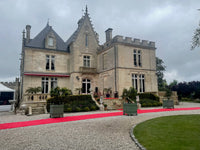The 1855 Bordeaux Classification, Second Growth Chateau Explained

Second Growth Bordeaux, Explained by Big Hammer Wines Bordeaux en Primeur Purchasing Program
Learn more at:BigHammerWines.com/pages/bordeaux-futures-en-primeur
If you read our post on the First Growths of Bordeaux, you learned a little bit about the 1855 classification that put the Chateaux of the left bank in a hierarchy from first to fifth growths. The rankings were largely based on the prices that the wines were being sold for at the time. The theory behind basing the ranking on the price was that the highest quality wines would fetch the highest prices. There are 14 chateaux in total that are ranked at the Second Growth level.
 The Second growths (Deuxieme Cru in French) sit on the tier directly below the First growths, in essence ranking them second best. That being said, there is some precedence of Second Growths being promoted to First growth, with Mouton Rothschild being moved up in 1973. There is also strong precedence for a lot of these second growths producing wine on the same level as the first growths. Colloquially, the wines that outperform their second growth ranking are referred to as ‘Super Second Growths.’ The Super Seconds are not only recognized for the high-quality wine, but they also command higher prices.
The Second growths (Deuxieme Cru in French) sit on the tier directly below the First growths, in essence ranking them second best. That being said, there is some precedence of Second Growths being promoted to First growth, with Mouton Rothschild being moved up in 1973. There is also strong precedence for a lot of these second growths producing wine on the same level as the first growths. Colloquially, the wines that outperform their second growth ranking are referred to as ‘Super Second Growths.’ The Super Seconds are not only recognized for the high-quality wine, but they also command higher prices.
What are the Bordeaux Second Growth Wineries?
Chateau Rauzan-Segla, Margaux
 Rauzan-Segla was founded in 1661 by Pierre de Rauzan, the former estate manager of Chateau Margaux. The Rauzan Family has ties across many of the classified growths. Rauzan Gassies was founded by a split in the family inheritance. The family once owned the vineyards that would later become Pichon Baron and Pichon Lalande. The estate was a favorite of Thomas Jefferson, who declared it top of the Second Growths during his visit to Bordeaux.
Rauzan-Segla was founded in 1661 by Pierre de Rauzan, the former estate manager of Chateau Margaux. The Rauzan Family has ties across many of the classified growths. Rauzan Gassies was founded by a split in the family inheritance. The family once owned the vineyards that would later become Pichon Baron and Pichon Lalande. The estate was a favorite of Thomas Jefferson, who declared it top of the Second Growths during his visit to Bordeaux.
Chateau Rauzan-Gassies, Margaux
Founded after a Rauzan Brother decided he wanted to produce wine on his own, separate from the Rauzan-Segla label. With a more recent history, the chateau is looking to the future. The estate has recently invested a lot of time and money into both its production facility and a tasting room. Good things are on the horizon for this house.
Chateau Leoville-Las Cases, St-Julien
The Leoville Chateaux were once all a part of the same estate. In the beginning, the estate was called Mont-Moyte and was one of the very first Chateau to produce wine in the Medoc alongside Margaux and Latour. It wasn’t until 100 years after founding that the estate was renamed Leoville. Through large land acquisitions, the estate grew to be one of the largest in all of Bordeaux. The French revolution led to selling off the portion that is now called Leoville Barton. Later a family split Las Cases from Poyferre. Las Cases has remained in the same family for over the last 100 years and has dramatically improved over the last 50.
Chateau Leoville-Poyferre, St-Julien
Part of the most recent split in the Leoville estate, Poyferre was born by a sharing of inheritance. The estate was an early adopter of modern winemaking techniques. The Chateau hired big-name consultants before their names were even that big. Michel Rolland consulted here before he became the most influential enology consultant in the world. Today, Poyferre is still producing wine at a very high level and always improving.
Chateau Leoville-Barton, St-Julien
Barton was born of the French Revolution. When the Leoville estate was taken over, the Barton property was auctioned off separately from the rest. Where the Barton Family took over and renamed the property after themselves. The Barton family never got around to building a winemaking facility for the Leoville-Barton estate so instead, the wine has always been made at the sister property Langoa Barton.Leoville-Barton is one of only two estates to be held by the same ownership as when the estate was classified in 1855.
Chateau Durfort-Vivens, Margaux
This estate was another favorite of Thomas Jefferson, during his travels to Bordeaux. He ranked it just below Lafite, Latour, and Margaux. In more modern times, the estate was last sold in 1961 to the Lurton family. The Lurton family is well known throughout the wine world with numerous members who own wineries, vineyards, and estates in the New World and the Old World. The family has been making quick steps in trying to improve their product by moving to fully organic and biodynamic growing practices. The Lurton family has also fully updated their entire production facility within the Chateau.
Chateau Gruaud-Larose, St-Julien
The estate was formed in the early 1700s and has since changed hands half a dozen times. It was most recently purchased by the Taillan group and the Merlaut family in 1997. This wine group owns a variety of other properties including Ch. Haut-Bages Liberal (fifth growth), Ch. Ferriere (third growth), Ch. La Gurgue, Ch. Camensac (fifth growth), Ch. Chasse Spleen, and Ch. Gressier Grand Poujeaux.
Chateau Lascombes, Margaux
Chateau Lascombes has a long storied history as one may expect of a nearly 400-year-old estate. During World War 2 the chateau was used as a headquarters for allied forces, this may have been what led to the eventual purchase by American investors in the ’50s. Located just a short walk from Chateau Margaux, the upside potential for this site endless. Since then the property has been bought and updated several times all in the name of progress. Chateau Lascombes also brought on some important consultants, to improve their production methods.
Chateau Brane-Cantenac, Margaux
This estate got its start as Guilhem-Hosten, it wasn’t until the Baron of Brane purchased the estate that it took on its current moniker. For the Baron to make this purchase he had to raise funds, he achieved this by selling another property that he owned, that just happened to be Mouton Rothschild. Since its early years, owners and potential buyers saw the potential this estate had. Unfortunately, it hasn’t been until the beginning of this century that it started living up to that potential. That being said, Brane-Cantenac is producing wines better than ever before and improving quality every year.
Chateau Pichon Longueville Baron, Pauillac
Much like the Leoville estates, the Pichon Longueville estates were once a single entity that was divided amongst heirs. In this case, the two sons of the Baron took their shares to continue producing wine at the Chateau Pichon Longueville Baron. The estate has recently returned its product to the level that it had gained recognition for. It wasn’t until the late ’80s and even more so the early 2000’s that this estate was truly living up to its potential.
Chateau Pichon Longueville Comtesse de Lalande, Pauillac
Comtesse de Lalande was founded by the female heirs to the Pichon Baron estate, separating production from their brothers. The estate has always produced high-quality wine and is continuing to do so today under the ownership of Louis Roederer Company. They have recently renovated the entire production facility, to bring it to a fully modern winery.
Chateau Ducru-Beaucaillou, St-Julien
Ducru Beaucaillou takes its name from the stones that lie in the vineyards as Beaucaillou translates to beautiful pebble. The estate is one of the oldest in the Medoc, with records dating back to the 13th century. The Borie family has been at the helm of the estate since 1940, consistently looking to improve. They even received the wine of the vintage from Wine Spectator for their 1995 vintage.
Chateau Cos d’Estournel, St-Estèphe
An incredibly popular estate on the left bank, with fairly recent history. Founded just in the 1800s this estate got its start selling wine directly to consumers, many of whom resided in India. The wines produced here have always been highly regarded, even before the 1855 classification. The winemaking facility is fully modernized and is entirely gravity-fed.
Chateau Montrose, St-Estèphe
Chateau Montrose is named for the blooming heather that once grew where the vineyard is now located. The estate has changed hands several times, it was once even a part of Chateau Calon Segur. The wines produced here have always been top tier, and within the last two decades, the estate has done its best to make these deep powerful wines as green as possible. The Chateau is now mostly powered by solar and wind energy, they are heated and cooled with geothermal pumping, there have even been drastic improvements to the insulation.
All of the producers ranked at this level still are and will continue to be seen in high regard for the foreseeable future. The Bordeaux Second Growths provide very storied wines, that often perform at or very near the level of the First Growths at a fraction of the price. You will never be able to replace the terroir of any given chateau, but having comparable options available always provides welcome relief for buyers.
If you want to learn about 1st Growth, 3rd Growth, and 4th Growth, and 5th Growth, click over.
Big Hammer Wines
The wine experts at Big Hammer Wines taste thousands of wines every year from around the globe, looking for quality and value. This special offer reflects the passion we have for our clients.
Discover the world through its wines, ClickHere! Visit Bighammerwines.com and become a wine expert!


